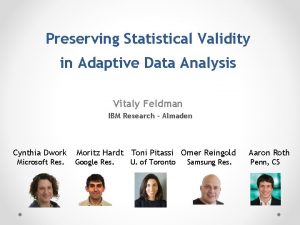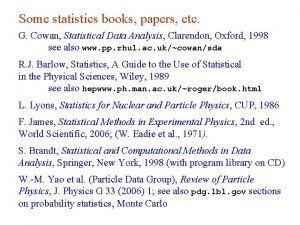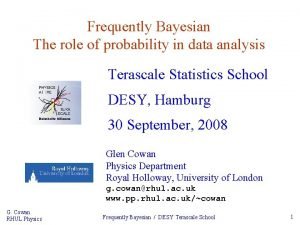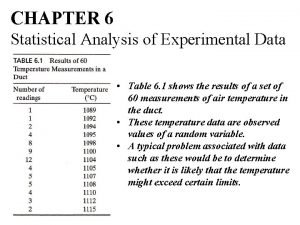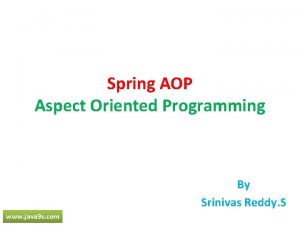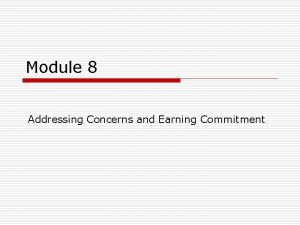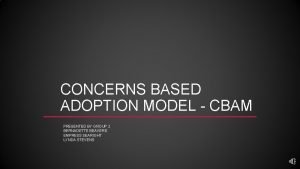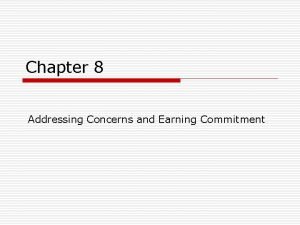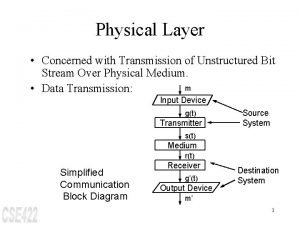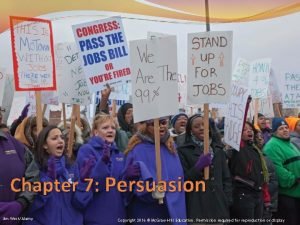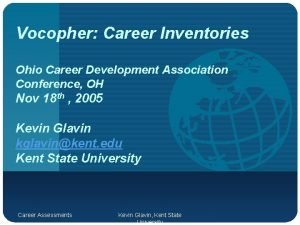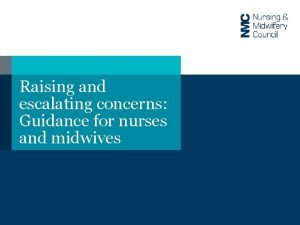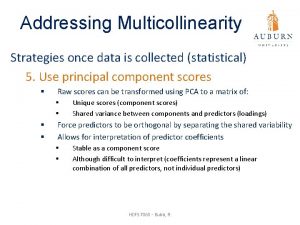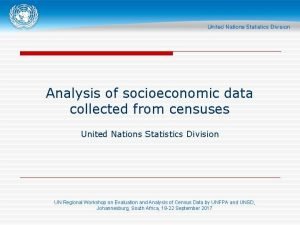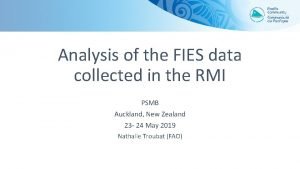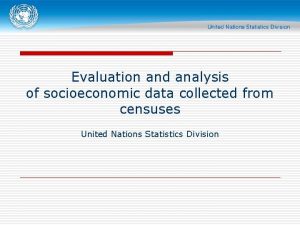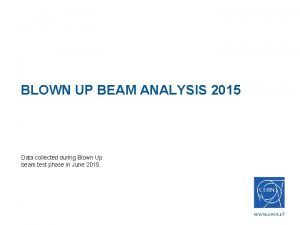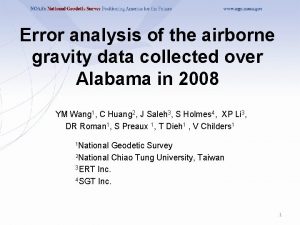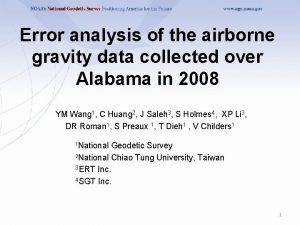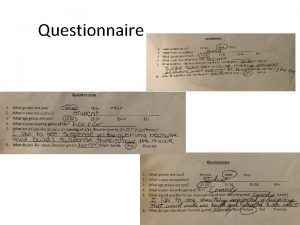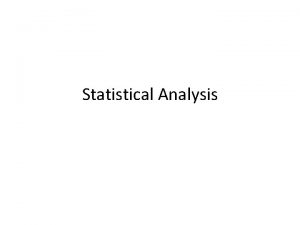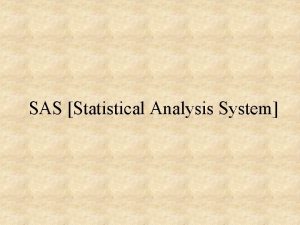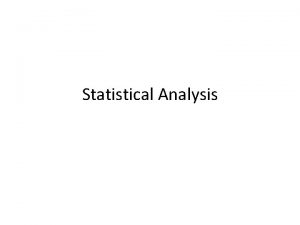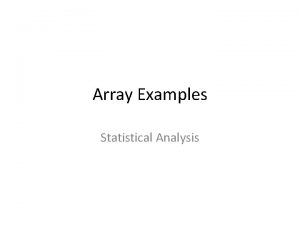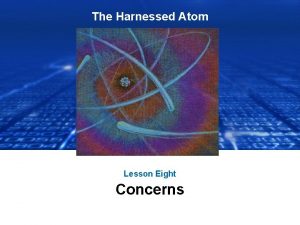Statistical Concerns for the Analysis of Data Collected

































- Slides: 33

Statistical Concerns for the Analysis of Data Collected by Wearable Digital Health Technology in Clinical Trial Andrew Potter, Ph. D Division of Biometrics 1, OB/OTS/CDER, FDA PSI Webinar– March 2, 2021 Virtual www. fda. gov

Disclaimer This presentation reflects the views of the author and should not be construed to represent FDA’s views or policies. www. fda. gov 2

Outline • Wearable Accelerometer measuring Activity – Missing Data – Different Follow‐up Time – Statistical Methods • Case Study: Sleep measurement – Week day vs weekend variation – Missing Data www. fda. gov 3

Digital Health Technology • Digital Health Technology (DHT) – Broad category of technology relating to health applications • Focus in this presentation on DHTs measuring clinical endpoints or physiological data in clinical studies • Examples: – Smart watches – Continuous blood glucose monitors (CBGM) – Activity monitors (accelerometers) 4

Activity Data • A wearable accelerometer is used to measure free living exercise – Data is recorded when the device is worn – Aggregated into 1 minute epochs – At least 1440 data points per day • Periods without recorded activity – Sleep? – Not wearing the device? • Patients may wear the device for different times each day • What may happen? How does it effect statistical analysis? 5

Example Daily Activity Counts • Sample subject from NHANES 2003‐ 2004 dataset • Each curve – activity count at a minute • Red curve is mean of daily curves • How to summarize? – The entire curve? – Features of the curve? 6

Activity Data as a Study Endpoint • Consider an investigation drug X that is hypothesized to improve exercise • Patients are followed for 6 weeks • Can a wearable accelerometer measure exercise? • Endpoint is related to daily total exercise change over 6 weeks – Total steps? – Time spent in moderate to vigorous physical activity? – Walking speed? • What time scale for baseline exercise and Week 6 exercise? 7

How data can go missing • Missing data can occur at multiple time scales (minute, day, week, etc) • At the minute scale: – DHT does not record the physical quantity – Patient removes DHT to go swimming – Etc • At the day scale: – Patient is feeling sick and does not put on the DHT • At the week scale: – Patient drops out of the study 8

Missing Data in Activity Data – Within Day MCAR MNAR M M M M Days Intervals within Days M M M M M M Days 9

Missing Data in Activity Data – Monotone Dropout and Within Day MCAR M M M M M M M M Days M M M M M Days Intervals within Days M MNAR M M M M Days 10

• ANCOVA Potential Statistical Analyses – Use baseline and 6 week exercise data – Missing data assumption: MCAR for all missing data • MMRM on the weekly summarized data – Uses every week of data – Missing data assumption: MAR for longitudinal and MCAR for within day and week measurements • Mixed model on the daily summarized data – Missing data assumption: MAR for missing days and MCAR for within day measurements • Functional regression models on the minute level data – Missing data assumption: MAR for both within day missing and longitudinal dropout • Other methods? 11

A Common Approach for Activity Data • Calculate daily activity summary endpoint Aday if – Patient wears accelerometer for at least T hours • T is often 8, 10, or 12 hours • Consider this a valid day • Calculate weekly activity summary endpoint Aweek if – Patient has at least W (often 3‐ 4) valid weekday measurements – Patient has at least U (often 1) valid weekend measurements • Some proposals include standardizing Aday to a common day length • This method assumes that missing epochs are missing at random (MCAR) – Is this justifiable? 12

CASE STUDY - SLEEP 13

Total Sleep Time • Measure of how long a person sleeps during the night • Usually measured with polysomnography (PSG) – PSG determines sleep/awake by measuring brains electrical activity – Read by expert readers • Can motion detected by an accelerometer be processed to determine time spent sleeping? – Algorithms classify each time epoch into sleep/awake using motion data – Utility depends on sensitivity and specificity of this classification – Provides daily sleep data 14

Total Sleep Time Derived from Acceleration Sensor High device wear Low device wear Calendar Day 15

Weekday to Weekend Variability In Total Sleep Time Weekday mornings Weekend mornings 16

Weekday to Weekend Variation ‐ Sleep • Case Study of analysis of the longitudinal evolution of the daily sensor data • Illustrate an approach to analyzing longitudinal evolution using total sleep time (TST) as a summary measure of daily sensor data • Compare changes in TST between a new sleep medication to placebo over four weeks • Focus on modeling the linear trend in TST in both groups • Use all observed data • Calculation of TST at specific time points conducted after statistical modeling • Framework extends to multiple sleep parameters and functional models 17

• Simulated data: • • Case Study ‐ Sleep 300 patients 30 minute improvement in TST by day 15 Similar change in TST to several NDAs submitted to FDA Complete data vs. Monotone dropout • Measure treatment effect by: • Difference in TST at four weeks • Estimate after modeling vs. calculate average before modeling (NA if any day missing) • Average TST trajectory in each group – model on the linear part of the trend • Use two statistical models • Linear mixed model • Linear functional form of time with random slopes and adjustment of day of week • Factor for week with days correlated within week and adjustment of day of week • Factor for week and no adjustment for day of week in the model • Generalized estimating equation (GEE) model – robust to misspecification of covariance between days 18

Case Study ‐ Sleep Total Sleep Time • time 19

Simulated Clinical Trial – The Data Example Subjects Subject Specific Change from Baseline in TST 44 83 Triangles – Weekday Red Circles ‐ Weekend 20

Simulated Clinical Trial – The Data with Dropout Example Subjects Subject Specific Change from Baseline in TST 44 83 Triangles – Weekday Red Circles ‐ Weekend 21

Population Average Total Sleep Time Trajectories Complete Data Monotone Dropout 22

Complete Data Weeks LMM – Linear Function of Time LMM – Factor for week including days Weeks LMM – Pre‐model averaging for week GEE – Linear Function of Time 23

Monotone Dropout Weeks LMM – Linear Function of Time LMM – Factor for week including days Weeks LMM – Pre‐model averaging for week GEE – Linear Function of Time 24

Estimated Treatment Effects Model Complete Data Estimated Daily Δ (min) TST difference at Day 28 TST difference at Week 4 Monotone Dropout 95% Confidence Interval p‐ value Estimate 95% Confidence Daily Δ (min) Interval p‐value LMM – Linear 37. 3 Function of Time and random slopes with day term 12. 8 61. 8 0. 003 31. 8 2. 0 61. 5 0. 037 GEE – Linear 25. 3 Function of Time and AR 1 working correlation with day term 0. 93 49. 7 0. 041 17. 3 ‐ 12. 9 47. 5 0. 262 LMM – Week as Factor with day term 24. 8 9. 1 40. 6 0. 002 14. 3 ‐ 4. 3 0. 131 LMM – Pre‐averaged week without with day term 24. 9 3. 4 46. 4 0. 023 5. 0 ‐ 23. 6 32. 79 0. 347 25

Conclusions • Missing data approaches can affect both the mean and standard error estimation • Different models can provide useful information even when mis‐ specified • Need to conduct model assessment • Need to conduct model diagnostics • Need to develop and conduct assessments of missing data approaches 26

References • Catellier DJ et al, Imputation of missing data when measuring physical activity by accelerometry. Med Sci Sports Exerc. 2005; 37(11 Suppl): S 555‐S 562. doi: 10. 1249/01. mss. 0000185651. 59486. 4 e • Song J et al, A semiparametric model for wearable sensor‐based physical activity monitoring data with informative device wear, Biostatistics, Volume 20, Issue 2, April 2019, Pages 287– 298. doi: https: //doi. org/10. 1093/biostatistics/kxx 073 • Byrom B and Rowe DA, Measuring free‐living physical activity in COPD patients: Deriving methodology standards for clinical trials through a review of research studies, Contemporary Clinical Trials, Volume 47, 2016, Pages 172 ‐ 184. doi: https: //doi. org/10. 1016/j. cct. 2016. 01. 006. 27


BACKUP SLIDES 29

Linear mixed model 1 30

Linear Mixed Model 2 31

Linear Mixed Model 3 32

Generalized Estimating Equation (GEE) Working correlation matrix is AR(1) Standard errors estimated with sandwich estimator All other terms defined previously 33
 Qualitative vs quantitative data analysis
Qualitative vs quantitative data analysis Preserving statistical validity in adaptive data analysis
Preserving statistical validity in adaptive data analysis Cowan statistical data analysis
Cowan statistical data analysis State bayes theorem
State bayes theorem Statistical analysis of experimental data
Statistical analysis of experimental data Scientists recently discovered that rocks collected
Scientists recently discovered that rocks collected How are ballistics collected
How are ballistics collected Conclusion of skimming and scanning
Conclusion of skimming and scanning Pronoun
Pronoun Cross-cutting concerns
Cross-cutting concerns Software design separation of concerns
Software design separation of concerns Design issues of network layer
Design issues of network layer Addressing concerns and earning commitment
Addressing concerns and earning commitment What are the concerns of the constitutions?
What are the concerns of the constitutions? Lumi sps
Lumi sps Concerns-based adoption model
Concerns-based adoption model Southwest airlines ethics and social responsibility
Southwest airlines ethics and social responsibility Earning commitment
Earning commitment Joys and concerns images
Joys and concerns images Joys and concerns prayer
Joys and concerns prayer Ddd cross cutting concerns
Ddd cross cutting concerns Miller's focal concerns
Miller's focal concerns The main issue in designing process layouts concerns what?
The main issue in designing process layouts concerns what? Maria zita molla
Maria zita molla Layouts that can handle varied processing requirements
Layouts that can handle varied processing requirements Health concerns
Health concerns The physical layer concerns with
The physical layer concerns with Identify concerns
Identify concerns Features of taiga
Features of taiga Health concerns
Health concerns When a choice concerns matters of personal value or taste
When a choice concerns matters of personal value or taste Joys and concerns images
Joys and concerns images Adult career concerns inventory
Adult career concerns inventory Escalating concerns in nursing
Escalating concerns in nursing

